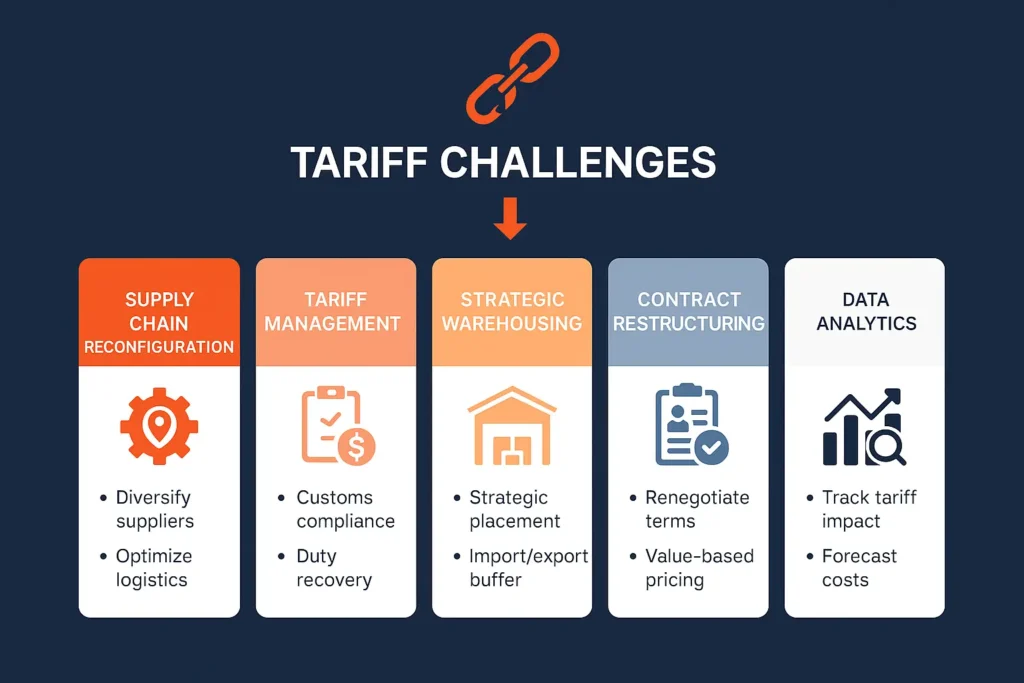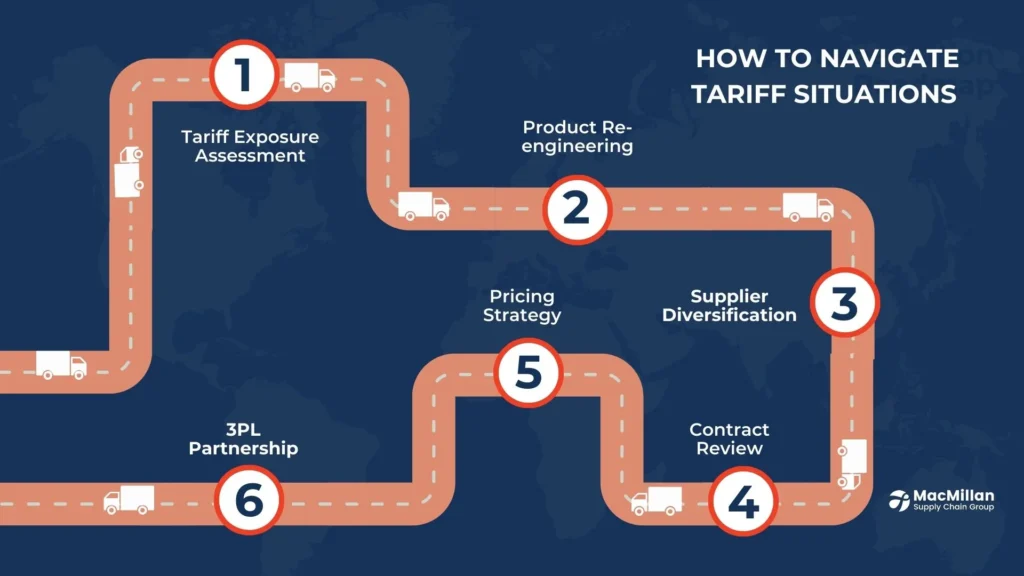A Quick Summary and Overview
In a strong response to President Trump’s massive “reciprocal” tariffs, Canada announced 25% duties on $30 billion worth of American goods, which could rise to $155 billion if U.S. actions continue. Although economic factors like factory reshoring also play a part, border security issues particularly the fentanyl crisis are at the heart of this trade disagreement. The debate poses a threat to the USMCA pact, raises consumer prices, and disrupts supply networks. While maintaining diplomatic efforts to settle the conflict, both countries have put policies in place to safeguard their own sectors. Businesses conducting cross border trade in this unpredictable climate must understand these developments.
Introduction
The United States-Canada trade relationship is currently dealing with its biggest obstacle in a long time. Citing border security and fentanyl trafficking fears, President Trump has placed new “reciprocal” tariffs on Canadian goods. Canada has responded by announcing a phased strategy of retaliatory tariffs that may eventually affect U.S. exports worth up to $155 billion.
Businesses on both sides of the border will be significantly impacted by this intensifying trade war. Decades-old supply networks are suddenly being disrupted, costs are increasing, and businesses need to quickly adjust to the new economic climate. The USMCA pact, which was designed to guarantee stable trade relations between the two countries, is also put to the test by this conflict.
For Canadian businesses and those engaged in US-Canada trade, understanding the scope, causes, and potential outcomes of this dispute is essential for strategic planning. Let’s examine the situation and its implications for your business operations.

Comprehending the New Tariffs in Canada
There are two different stages to Canada’s reaction to Trump’s tariffs. About $30 billion worth of American goods are subject to 25% tariffs under the first phase, which is now in place. These initial retaliatory tariffs strategically target products with political significance in the U.S., including orange juice from Florida, beer from various states, household appliances, cosmetics, and pulp/paper products.
The careful choice of these Canada tariffs is what gives them their unique impact. Products that will generate pressure points in politically sensitive areas of the United States have been selected by the Canadian government. Targeting agricultural items, for instance, has an impact on farming communities, which frequently hold considerable political influence.
The mechanics of these tariffs are straightforward: when these American products cross the Canadian border, importers must pay an additional 25% tax.This raises the cost of U.S. goods for Canadian companies and consumers, which may lower demand and cause purchases to shift to domestic or other foreign providers.
Canada is willing to carry out a second round of retaliatory measures that would extend to cover up to $125 billion in more American goods if the U.S. keeps its tariffs in place. The economic impact of the trade conflict would be greatly increased by this second phase, which would target electronics, cattle, dairy goods, and electric vehicles.
Impact on US-Canada Trade Relations
The US-Canada trade relationship has historically been one of the world’s largest and most integrated. Bilateral commerce in goods and services was valued at over $800 billion in 2023. Because of this deep economic connectivity, tariffs have an impact on interconnected supply chains as well as individual items.
The current trade war poses several risks to this cooperation.. Initially, it upsets long-standing supply chains that span the border several times throughout manufacturing. For instance, before a vehicle is finished, auto parts may cross the border seven times. New levies could now be applied to every crossing, increasing expenses.
Second, companies preparing to expand or make investments are left in the dark by these interruptions. Businesses might put off making decisions until the trade environment calms down, which might hinder economic growth on both sides of the border.
Third, the disagreement calls into question the basic principles of the USMCA, which was created to offer a secure framework for commerce within the region. Canada argues that the U.S. tariffs violate this agreement by avoiding the established conflict resolution procedures. This undermines confidence in the North American trade deal.
These developments necessitate rapid attention to pricing strategies, supply chain resilience, and possible market diversification for companies involved in cross-border trade in order to reduce risks.
The Link Between Fentanyl and Border Security
The way the United States has connected tariffs to border security issues, specifically fentanyl trafficking, is an unusual aspect of this trade war. The Trump administration asserts that the flow of illegal drugs into the United States is facilitated by Canada’s inadequate border security practices.
With thousands of American lives lost, the fentanyl pandemic is a powerful political issue. The U.S. administration has complicated what could otherwise be a simple commercial issue by linking trade policy to this public health disaster.
Canada has responded to these concerns by appointing Kevin Brosseau as a dedicated “fentanyl czar” to coordinate anti-trafficking efforts.In order to strengthen law enforcement’s ability to combat drug smuggling, the Canadian government has also labeled seven transnational criminal groups as terrorist entities.
However, Canadian officials dispute the American portrayal of the problem, pointing out that less than 1% of fentanyl entering the US goes via Canada. According to Canadian data, the majority of illegal fentanyl in the United States comes from Mexico or enters the country straight from China.
Because it shifts the conflict from typical economic negotiations to more extensive diplomatic and security cooperation, this security dimension makes efforts at resolution more difficult. This implies that for companies, the route to tariff removal can rely on advancements in fields unrelated to normal business concerns.
Canada’s Support for Affected Industries
The Canadian government has put in place a number of support systems for industries impacted by both U.S. tariffs and Canada’s retaliatory actions in recognition of the possible harm to domestic companies.
The remission procedure, which enables Canadian businesses to ask for exemptions or relief from retaliatory tariffs if doing so would significantly damage their operations, is at the heart of this support. This procedure recognizes that certain companies are unable to locate substitute suppliers in a timely manner and rely significantly on U.S. inputs.
In addition to the remission process, the government has stated that it will use Crown corporations to offer financial assistance to companies who are having cash flow problems as a result of the tariffs. To help businesses weather the trade storm, this might involve direct financing, loan guarantees, or longer payment periods.
If trade disruptions lead to layoffs, workers in hard-hit sectors may be eligible for higher Employment Insurance benefits. If some industries see disproportionate effects, the government has stated that it is prepared to put sector-specific support programs into place.
The following Canadian industries are particularly at risk from the trade dispute:
- Manufacturing, especially businesses that are a part of supply chains in North America
- Food processing and agriculture are subject to U.S. tariffs and possible retaliation actions.
- Resource industries that export substantial amounts to the United States include mining and forestry.
- Creating backup plans and investigating market diversification have become top priorities for these industries.
Common Problems with the Tariff Situation
Businesses and the overall economy face a number of serious difficulties as a result of the growing tariff conflict between the United States and Canada:
- Supply Chain Disruptions: Businesses with integrated cross-border operations deal with more complicated logistics planning, delivery delays, and fragmented supply chains. Previously free-moving parts and supplies now need extra paperwork and could be delayed at customs.
- Cost Inflation: Import duties raise the price of items directly, which puts pressure on prices across the supply chain. Businesses may absorb these expenses, which would lower their profit margins, or they may be passed on to customers, which would lower their purchasing power.
- Regulatory Uncertainty: The business environment is unclear due to the gradual introduction of tariffs and the potential for exemptions. Long-term planning is difficult for businesses when regulations can change suddenly.
- Market Access Barriers: In addition to tariffs, there is fear that non-tariff barriers, such stricter inspection standards or regulatory obstacles, may appear and make cross-border trade even more difficult.
- Contractual Difficulties: Businesses may be unsure of who will pay for these additional expenses if substantial tariff hikes are not taken into account by current contracts. Although difficult, renegotiating terms with suppliers and customers becomes essential.
- Resource Reallocation: Businesses must shift their attention from innovation and growth projects to supply chain reconfiguration, tariff management, and customs compliance.
- Financing Strains: Some organizations find it challenging to sustain operations or obtain funding for expansion due to the impact on cash flow caused by rising expenses and possible revenue declines.
- Competitive Drawbacks: Canadian businesses who are exposed to tariffs in the US market risk losing market share to rivals from nations that are not affected by comparable policies, which could harm their position in the long run.

Our Remedies
We at MacMillan Supply Chain Group have established all-encompassing plans to assist companies in overcoming the obstacles brought about by the tariff conflict between the United States and Canada. Both short-term operational issues and long-term strategic planning are addressed by our solutions:
Supply Chain Reconfiguration
We help companies analyze their current supply chains to identify vulnerabilities and opportunities for restructuring. Creating alternate sourcing plans for essential components and mapping whole supply networks to pinpoint tariff vulnerability locations are two examples of this.
- Developing planning for buffer inventories of necessary supplies
- Putting in place cutting-edge tracking technologies to keep an eye on shipments and foresee delays
Services for Tariff Management
To reduce the effects of tariffs, our customs and trade specialists offer specialized assistance:
- Thorough categorization evaluations to guarantee precise tariff assignment
- Helping qualified businesses submit remission petitions; creating plans for mitigating tariffs, such as possible product redesigns
- Optimizing customs paperwork to cut down on border delays
Warehousing and Distribution Adaptations
We offer flexible warehousing solutions to address changing distribution needs:
- Strategic warehouse locations on both sides of the border to enable rapid market access
- Cross-docking services to minimize handling and speed transit
- Inventory positioning strategies to reduce cross-border movements
- Consolidated shipping options to reduce per-unit customs processing costs
Last-Mile Delivery Optimization
Despite supply chain interruptions, our last-mile experience guarantees that items reach customers:
- Route planning that takes possible border delays into consideration
- Different delivery schedules to account for extended lead times
- Technology integration for customer communication and real-time tracking – Backup plans for important shipments
Restructuring Contract Logistics
We collaborate with customers to update logistics agreements to reflect the following new realities:
- Reviews and revisions to force majeure clauses
- Cost-sharing arrangements for costs associated with tariffs
- Modifications to performance metrics to account for evolving conditions
- Adaptable capacity configurations to handle variations in volume
Forecasting and Data Analytics
Our sophisticated analytics tools assist companies in anticipating and adapting to shifting circumstances:
- Modeling the effects of tariffs on various product categories
- Price elasticity-based changes to demand forecasts; scenario planning for different trade dispute outcomes; and cost optimization modeling to find areas for savings
By implementing these solutions, we’ve helped clients maintain operational continuity while minimizing the financial impact of tariffs. Our comprehensive strategy solves current issues while setting up companies for long-term success in a changing trade environment.
How to Handle the Tariff Scenario
Companies who are impacted by the tariff dispute between the United States and Canada can take a number of preventative measures to safeguard their business and set themselves up for future success. Here’s how to put these strategies into practice:
Do a thorough assessment of tariff exposure first. Examine your entire supply chain and product portfolio to determine whether items are directly impacted by Canadian or U.S. tariffs. Prioritize high-risk products for prompt action and calculate the possible financial effect.
Next, explore product re-engineering opportunities. In some cases, minor modifications to product specifications or country of origin can significantly alter tariff classification. Collaborate with product development teams to find potential alterations that might lower tariff liability without compromising the integrity of the final product.
Think about expanding your supplier network outside of North America. Starting this process now gives options in case the trade war lasts longer than expected, even though building new supplier connections takes time. To get the most flexibility, look for suppliers in nations that have free trade agreements with both the United States and Canada.
Examine your contracts and pricing plan right away. Ascertain which tariff expenses must be absorbed and which can be passed on to consumers. Look for provisions in long-term contracts that might permit renegotiation in response to material cost changes, such as tariffs.
Don’t face these obstacles by yourself. Access to specialist knowledge in supply chain optimization, international logistics, and customs compliance is made possible by working with a seasoned 3PL partner like MacMillan Supply Chain Group. Our staff is up to date on regulatory developments and can assist in putting solutions in place that are customized for your specific situation.
To discuss how MacMillan Supply Chain Group can assist your company in adjusting to the evolving trade environment, get in touch with us right now. Despite tariff difficulties, our integrated warehouse, distribution, and last-mile delivery services offer the adaptability and know-how required to preserve company continuity. Allow us to assist you in transforming this disruption into a chance to create a supply chain that is more robust and competitive.
FAQS
Canada has implemented 25% tariffs on $30 billion worth of American goods, including orange juice, beer, appliances, and cosmetics. If U.S. tariffs continue, Canada plans to expand these measures to cover up to $155 billion in American exports, including electric vehicles, beef, and electronics.
The tariffs create additional costs and complexity for cross-border trade, disrupting supply chains that have been integrated for decades. Companies may face higher input costs, delayed shipments, and challenges maintaining competitive pricing in both markets.
The U.S. has linked its tariffs to border security concerns, particularly regarding fentanyl trafficking. While Canada disputes the characterization that significant amounts of fentanyl enter the U.S. from Canada, they've appointed a fentanyl czar and designated criminal organizations as terrorist entities to address these concerns.
Canada argues that U.S. tariffs violate the USMCA by bypassing established dispute resolution mechanisms. The agreement was designed to ensure stable trade relations, but these unilateral tariffs challenge its effectiveness as a governing framework for North American trade.
The Canadian government offers several support mechanisms, including a remission process for tariff exemptions, financing support through Crown corporations, and potential Employment Insurance enhancements for affected workers. Sector-specific programs may be implemented if certain industries face disproportionate impacts.
Companies can mitigate tariff impacts by reassessing supply chains, exploring alternative sourcing, reviewing product specifications for potential classification changes, adjusting inventory strategies, and working with experienced logistics partners like MacMillan Supply Chain Group to navigate customs complexities.
Yes, the U.S. has exempted goods that qualify under USMCA preferences, particularly in the automotive sector. Canada's remission process allows companies to request exemptions if tariffs would significantly harm their operations. Both countries are trying to balance economic pressure with protecting critical industries.
The duration remains uncertain and depends on diplomatic negotiations, progress on border security cooperation, and political developments in both countries. Businesses should prepare for both short-term disruption and the possibility of an extended dispute by developing flexible, resilient supply chain strategies.
The most vulnerable sectors include manufacturing (especially automotive and electronics), agriculture and food processing, resource industries like forestry and mining, and consumer goods. Companies with highly integrated cross-border operations face the greatest challenges.
MacMillan Supply Chain Group offers comprehensive solutions including supply chain reconfiguration, tariff management services, strategic warehousing on both sides of the border, last-mile delivery optimization, contract logistics restructuring, and data analytics for forecasting and planning. Our expertise helps businesses maintain continuity while minimizing tariff impacts.




